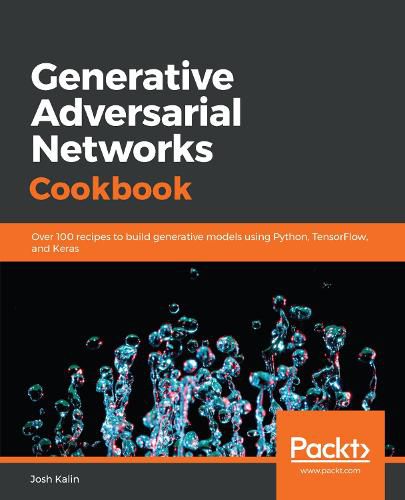Readings Newsletter
Become a Readings Member to make your shopping experience even easier.
Sign in or sign up for free!
You’re not far away from qualifying for FREE standard shipping within Australia
You’ve qualified for FREE standard shipping within Australia
The cart is loading…






This title is printed to order. This book may have been self-published. If so, we cannot guarantee the quality of the content. In the main most books will have gone through the editing process however some may not. We therefore suggest that you be aware of this before ordering this book. If in doubt check either the author or publisher’s details as we are unable to accept any returns unless they are faulty. Please contact us if you have any questions.
Simplify next-generation deep learning by implementing powerful generative models using Python, TensorFlow and Keras
Key Features
Understand the common architecture of different types of GANs Train, optimize, and deploy GAN applications using TensorFlow and Keras Build generative models with real-world data sets, including 2D and 3D data
Book DescriptionDeveloping Generative Adversarial Networks (GANs) is a complex task, and it is often hard to find code that is easy to understand.
This book leads you through eight different examples of modern GAN implementations, including CycleGAN, simGAN, DCGAN, and 2D image to 3D model generation. Each chapter contains useful recipes to build on a common architecture in Python, TensorFlow and Keras to explore increasingly difficult GAN architectures in an easy-to-read format. The book starts by covering the different types of GAN architecture to help you understand how the model works. This book also contains intuitive recipes to help you work with use cases involving DCGAN, Pix2Pix, and so on. To understand these complex applications, you will take different real-world data sets and put them to use.
By the end of this book, you will be equipped to deal with the challenges and issues that you may face while working with GAN models, thanks to easy-to-follow code solutions that you can implement right away.
What you will learn
Structure a GAN architecture in pseudocode Understand the common architecture for each of the GAN models you will build Implement different GAN architectures in TensorFlow and Keras Use different datasets to enable neural network functionality in GAN models Combine different GAN models and learn how to fine-tune them Produce a model that can take 2D images and produce 3D models Develop a GAN to do style transfer with Pix2Pix
Who this book is forThis book is for data scientists, machine learning developers, and deep learning practitioners looking for a quick reference to tackle challenges and tasks in the GAN domain. Familiarity with machine learning concepts and working knowledge of Python programming language will help you get the most out of the book.
$9.00 standard shipping within Australia
FREE standard shipping within Australia for orders over $100.00
Express & International shipping calculated at checkout
This title is printed to order. This book may have been self-published. If so, we cannot guarantee the quality of the content. In the main most books will have gone through the editing process however some may not. We therefore suggest that you be aware of this before ordering this book. If in doubt check either the author or publisher’s details as we are unable to accept any returns unless they are faulty. Please contact us if you have any questions.
Simplify next-generation deep learning by implementing powerful generative models using Python, TensorFlow and Keras
Key Features
Understand the common architecture of different types of GANs Train, optimize, and deploy GAN applications using TensorFlow and Keras Build generative models with real-world data sets, including 2D and 3D data
Book DescriptionDeveloping Generative Adversarial Networks (GANs) is a complex task, and it is often hard to find code that is easy to understand.
This book leads you through eight different examples of modern GAN implementations, including CycleGAN, simGAN, DCGAN, and 2D image to 3D model generation. Each chapter contains useful recipes to build on a common architecture in Python, TensorFlow and Keras to explore increasingly difficult GAN architectures in an easy-to-read format. The book starts by covering the different types of GAN architecture to help you understand how the model works. This book also contains intuitive recipes to help you work with use cases involving DCGAN, Pix2Pix, and so on. To understand these complex applications, you will take different real-world data sets and put them to use.
By the end of this book, you will be equipped to deal with the challenges and issues that you may face while working with GAN models, thanks to easy-to-follow code solutions that you can implement right away.
What you will learn
Structure a GAN architecture in pseudocode Understand the common architecture for each of the GAN models you will build Implement different GAN architectures in TensorFlow and Keras Use different datasets to enable neural network functionality in GAN models Combine different GAN models and learn how to fine-tune them Produce a model that can take 2D images and produce 3D models Develop a GAN to do style transfer with Pix2Pix
Who this book is forThis book is for data scientists, machine learning developers, and deep learning practitioners looking for a quick reference to tackle challenges and tasks in the GAN domain. Familiarity with machine learning concepts and working knowledge of Python programming language will help you get the most out of the book.